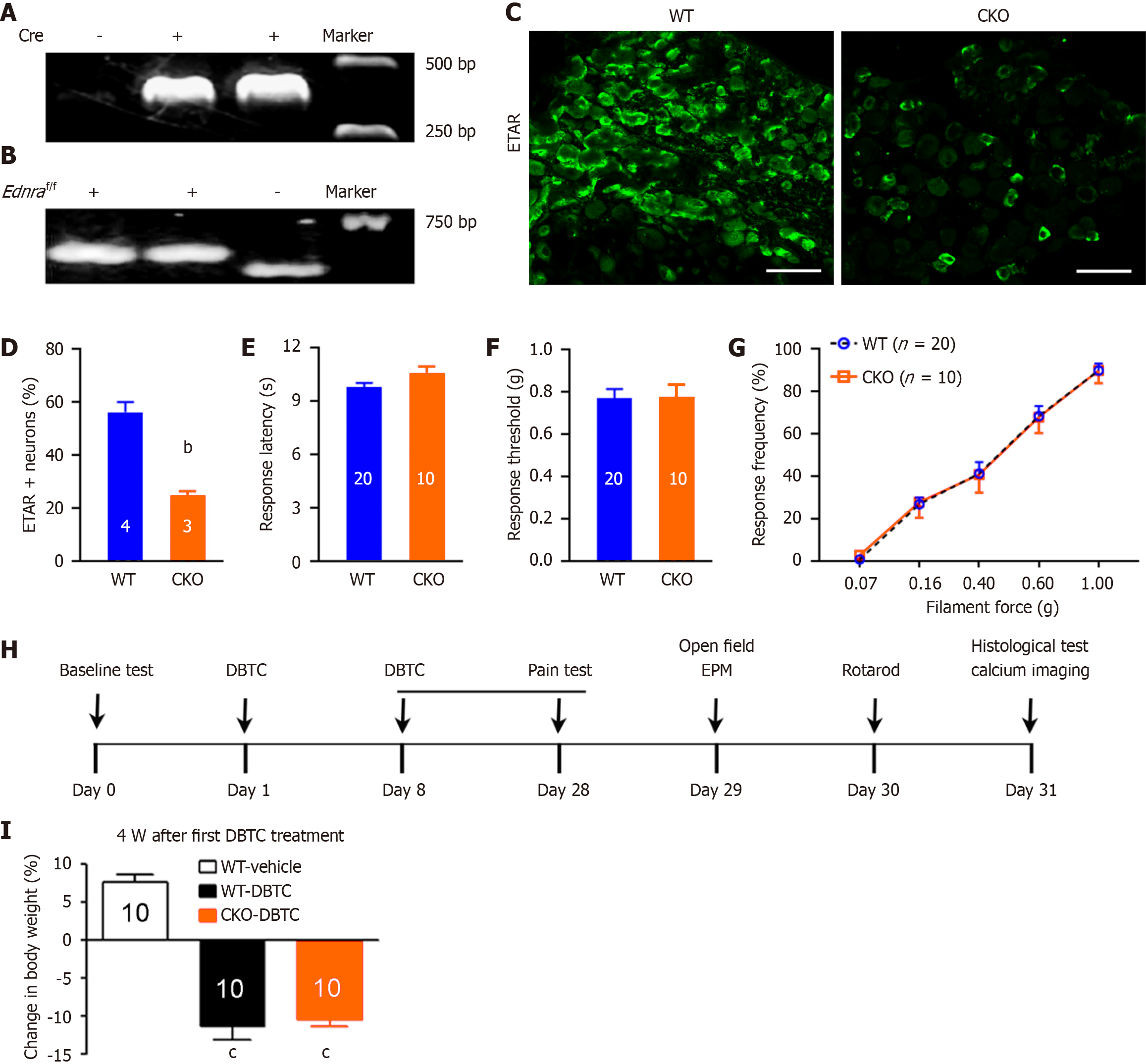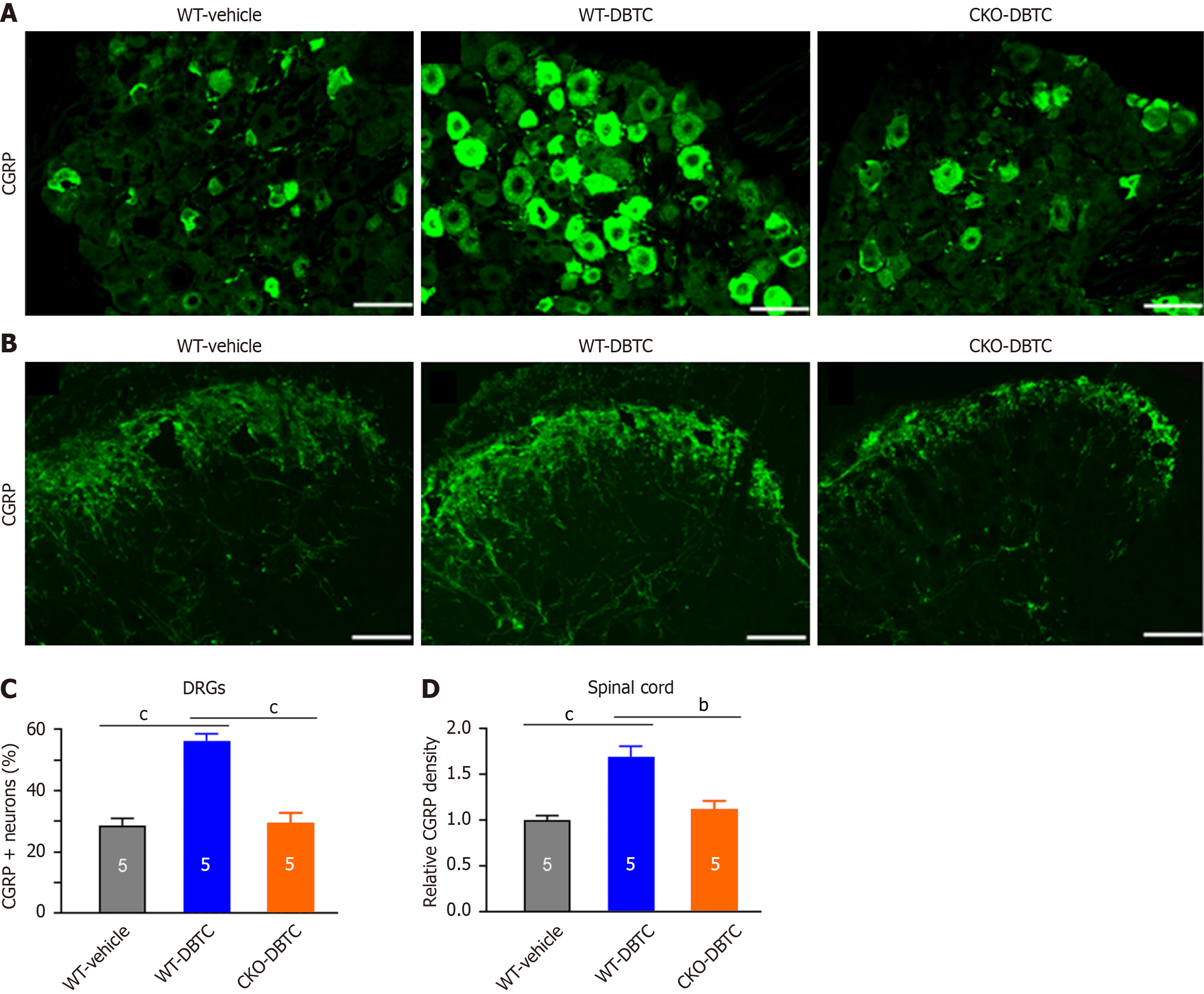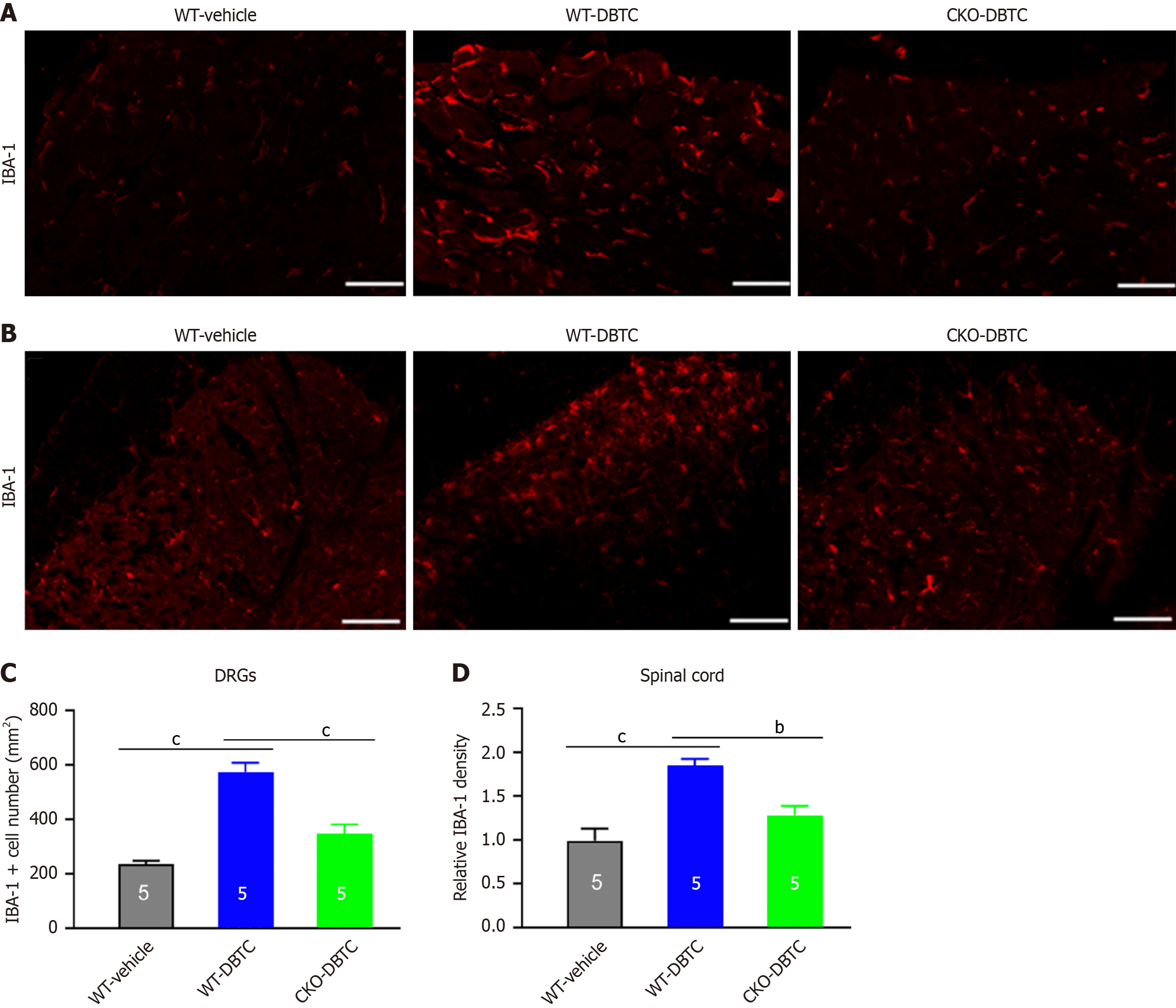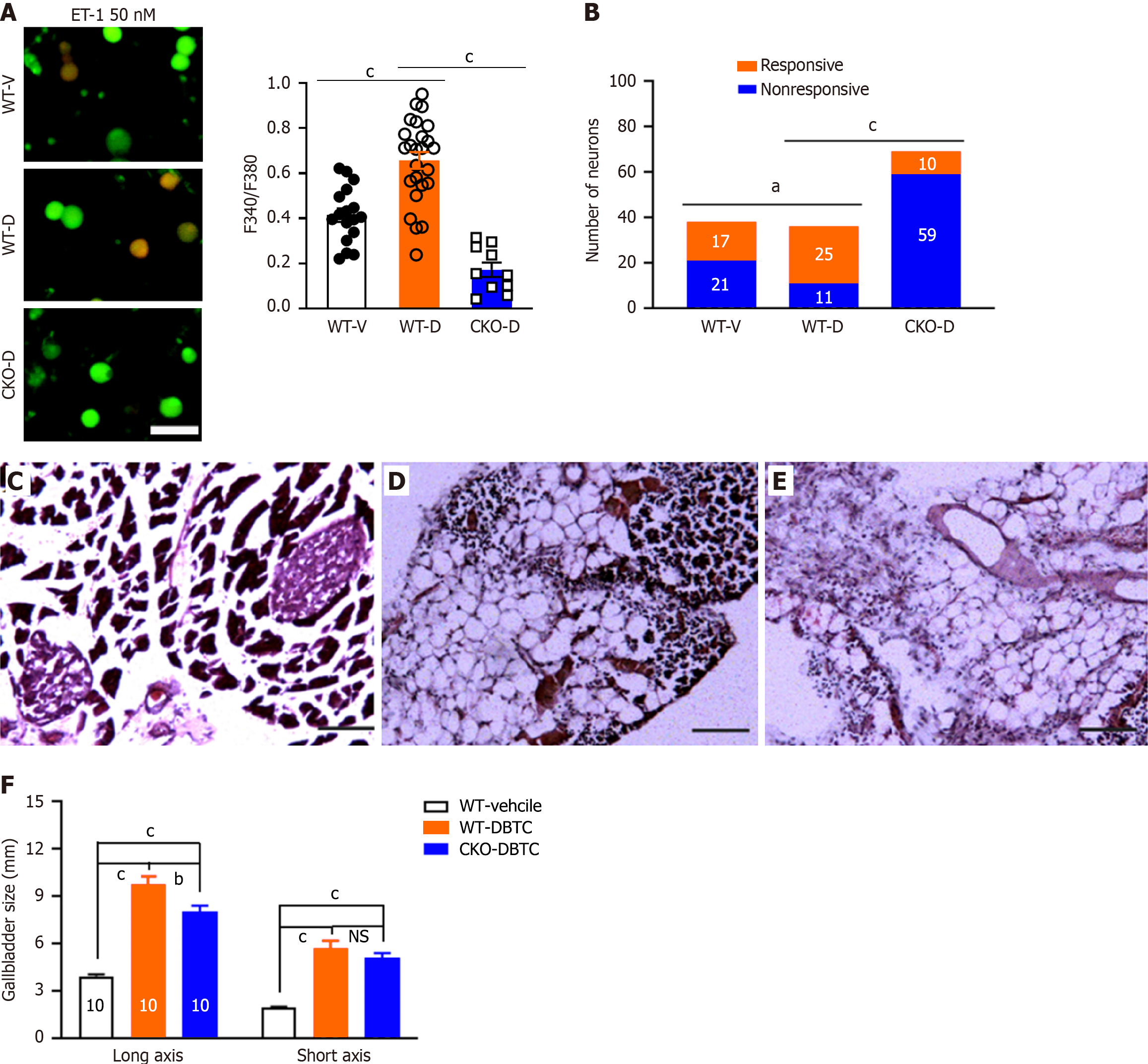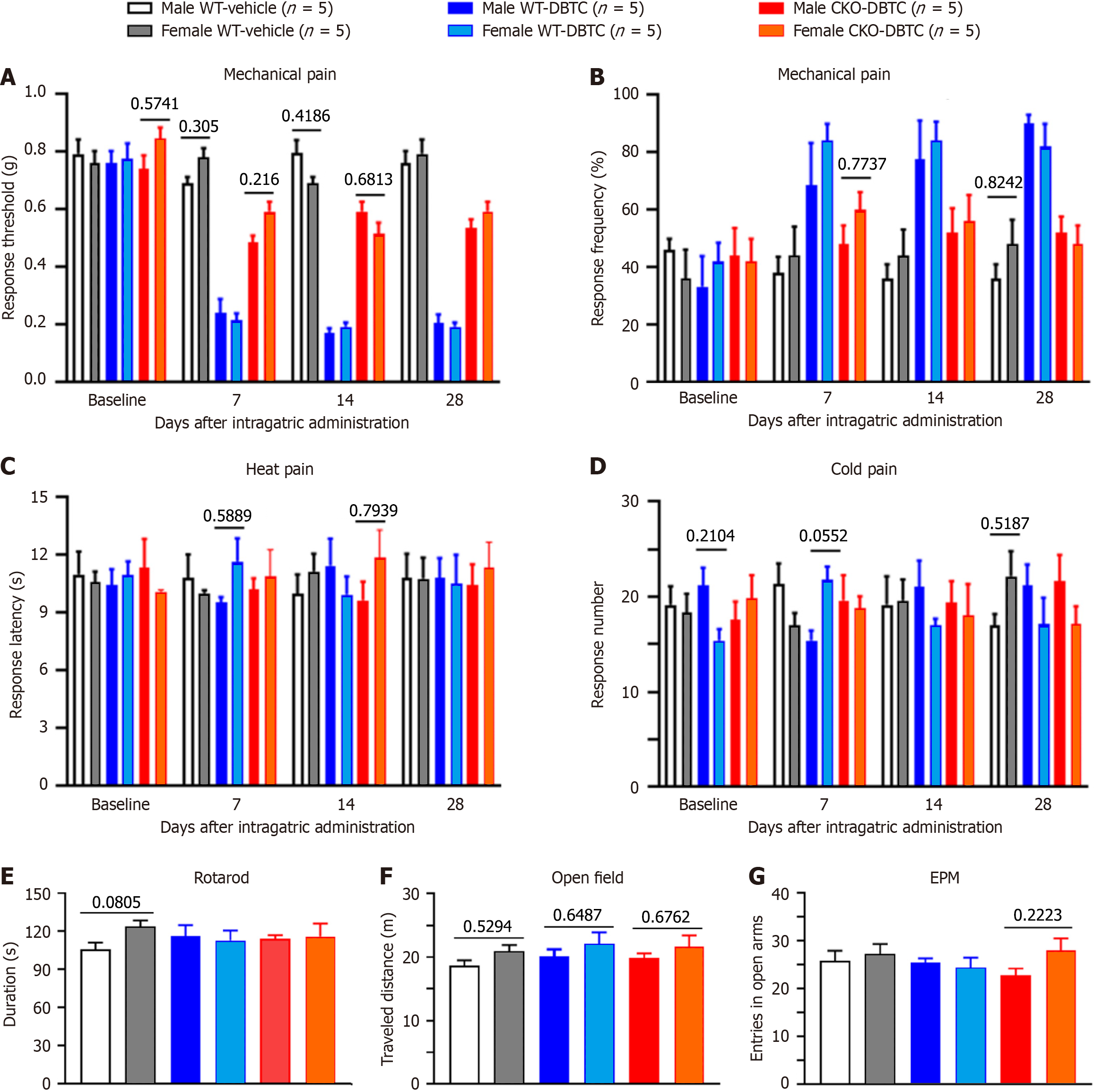Copyright
©The Author(s) 2025.
World J Gastroenterol. Jun 21, 2025; 31(23): 103848
Published online Jun 21, 2025. doi: 10.3748/wjg.v31.i23.103848
Published online Jun 21, 2025. doi: 10.3748/wjg.v31.i23.103848
Figure 1 Characterization of endothelin A receptor conditional knockout mouse line.
A: Polymerase chain reaction genotyping of SNS-Cre mice (Cre band: Approximately 350 bp); B Polymerase chain reaction genotyping of endothelin A receptor (ETAR)-flox mice (with flox band: Approximately 650 bp; without flox band: Approximately 610 bp); C: Representative immunofluorescence images showing ETAR (green) signals in dorsal root ganglion neurons from ETAR conditional knockout (CKO) and littermate wild type (WT) mice; D: Analysis of ETAR-positive dorsal root ganglion neuron percentage in WT and CKO mice; E: Radiant heat test was used to examine thermal nociceptive response latency in WT and ETAR CKO mice; F: Response threshold to abdominal mechanical stimulation was measured in WT and ETAR CKO mice with von Frey filaments; G: Von Frey filaments with different forces were applied to the abdomen of WT and ETAR CKO mice. The response frequency of each filament was calculated; H: The experimental flowchart; I: The percentage of body weight change of experimental mice around 4 weeks after with dibutyltin dichloride or vehicle treatment. Scale bar, 50 μm. n = 3-20 mice. Data are shown as mean ± SEM. bP < 0.01, cP < 0.001, statistical comparisons were conducted with unpaired two-tailed t-test (D-F), two-way analysis of variance (G) or one-way analysis of variance with Sidak’s post hoc test (I). Ednra: Endothelin receptor type A gene; WT: Wild type; CKO: Conditional knockout; ETAR: Endothelin A type receptor; DBTC: Dibutyltin dichloride; EPM: Elevated plus maze.
Figure 2 Behavioral phenotypes of dibutyltin dichloride -induced chronic pancreatitis model.
A: The response thresholds to abdominal mechanical stimulation were measured in experimental mice before and after chronic pancreatitis induction with von Frey filaments; B: Von Frey filament with 0.4-g force was applied to mouse abdomen and the response frequencies of mice were calculated; C: The abdominal response latencies to radiant heat were determined in mice from different groups; D: Acetone-induced nociceptive response events were counted to reflect mouse abdominal responses to cold stimuli; E: The fall latencies of mice were determined to reflect mouse motor abilities in rotarod test; F and G: The total travelled distance of mice was measured to reflect mouse motor activities (F) and the duration the central zone was recorded to reflect mouse mood alteration (G) in the open field test; H and I: The percentages of open arm entries (H) and duration in the open arm (I) were measured to reflect mouse anxiety-like behaviors in the EPM test. n = 10 mice. Data are shown as mean ± SEM. bP < 0.01, cP < 0.001, statistical comparisons were conducted with unpaired two-way analysis of variance (A-D) or one-way analysis of variance (E-I) with Sidak’s post hoc test. WT: Wild type; CKO: Conditional knockout; DBTC: Dibutyltin dichloride; EPM: Elevated plus maze.
Figure 3 Increased expression of calcitonin gene-related peptide in the dorsal root ganglion and spinal cord of mice with chronic pancreatitis.
A and B: Representative images of immunofluorescence staining of calcitonin gene-related peptide (CGRP) on the T8-12 dorsal root ganglion (DRG) neurons (A) and spinal cord (B); C: Percentage of CGRP-positive DRG neurons; D: Relative CGRP-positive fiber density (normalized to wild type-vehicle group) in the dorsal spinal cord was analyzed for each group of mice. Scale bar, 50 μm (A) and 100 μm (B). n = 5 mice. Data are shown as mean ± SEM. bP < 0.01, cP < 0.001, statistical comparison were conducted with one-way analysis of variance with Sidak’s post hoc test. CGRP: Calcitonin gene-related peptide; WT: Wild type; CKO: Conditional knockout; DBTC: Dibutyltin dichloride; DRG: Dorsal root ganglion.
Figure 4 Increased macrophage infiltration into the DRG and microglial activation in the spinal cord of mice with chronic pancreatitis.
A and B: Representative images of immunofluorescence staining of ionized calcium-binding adapter molecule 1 (IBA-1) on the T8-12 dorsal root ganglion neurons (A) and spinal cord (B); C: The number of IBA-1-positive cells; D: Relative IBA-1-positive density (normalized to WT-vehicle group) in the dorsal spinal cord was analyzed for each group of mice. Scale bar, 50 μm (A) and 100 μm (B). n = 5 mice. Data are shown as mean ± SEM. bP < 0.01, cP < 0.001, statistical comparison were conducted with one-way analysis of variance with Sidak’s post hoc test. WT: Wild type; CKO: Conditional knockout; DBTC: Dibutyltin dichloride; DRG: Dorsal root ganglion; IBA-1: Ionized calcium binding adaptor molecule 1.
Figure 5 A higher sensitivity in primary sensory neurons and histological characterization of mice with chronic pancreatitis.
A and B: Less sensitive to endothelin-1 in dissociated T8-12 dorsal root ganglion neurons from conditional knockout (CKO) mice with chronic pancreatitis than those from wild type (WT) mice with chronic pancreatitis measured by calcium imaging for the degree of calcium influx into the neurons (A) and the percentage of responsive cells from five mice (B). n = 36-69 neurons from 5 mice/group; C-E: Representative hematoxylin and eosin staining images of mouse pancreas sections from WT-vehicle group (C), WT-dibutyltin dichloride group (D), and CKO-dibutyltin dichloride group (E); F: The percentage of body weight change for experimental animals around 4 weeks. Scale bar, 50 μm (A) and 200 μm (C-E). n = 10 mice. Data are shown as mean ± SEM. aP < 0.05, bP < 0.01, cP < 0.001, statistical comparison were conducted with one-way analysis of variance with Sidak’s post hoc test (A and F) or χ2-test (B). WT: Wild type; CKO: Conditional knockout; D: Dibutyltin dichloride (DBTC); ET-1: endothelin-1; NS: Not significant; V: Vehicle.
Figure 6 Gender differences in behavioral phenotypes of dibutyltin dichloride -induced chronic pancreatitis model.
A and B: No gender difference was observed in mechanical pain sensitivity in experimental mice before and after chronic pancreatitis (CP); C and D: No gender differences were observed in heat pain sensitivity (C) and cold allodynia (D) in experimental mice before and after CP; E and F: No gender differences were observed in motor function (E) and autonomous activities (F) in experimental mice before and after CP; G: No gender differences were observed in emotional state in experimental mice before and after CP. n = 5 mice. Data are shown as mean ± SEM. Statistical comparisons were conducted with unpaired two-way analysis of variance (A-D) or one-way analysis of variance (E-G) with Sidak’s post hoc test. WT: Wild type; CKO: Conditional knockout; DBTC: Dibutyltin dichloride; EPM: Elevated plus maze.
- Citation: Wang B, Ge JY, Wu JN, Xu JH, Cao XH, Chang N, Zhou X, Jing PB, Liu XJ, Wu Y. Endothelin A receptor in nociceptors is essential for persistent mechanical pain in a chronic pancreatitis of mouse model. World J Gastroenterol 2025; 31(23): 103848
- URL: https://www.wjgnet.com/1007-9327/full/v31/i23/103848.htm
- DOI: https://dx.doi.org/10.3748/wjg.v31.i23.103848













